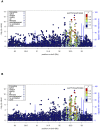A genome-wide integrative genomic study localizes genetic factors influencing antibodies against Epstein-Barr virus nuclear antigen 1 (EBNA-1)
- PMID: 23326239
- PMCID: PMC3542101
- DOI: 10.1371/journal.pgen.1003147
A genome-wide integrative genomic study localizes genetic factors influencing antibodies against Epstein-Barr virus nuclear antigen 1 (EBNA-1)
Abstract
Infection with Epstein-Barr virus (EBV) is highly prevalent worldwide, and it has been associated with infectious mononucleosis and severe diseases including Burkitt lymphoma, Hodgkin lymphoma, nasopharyngeal lymphoma, and lymphoproliferative disorders. Although EBV has been the focus of extensive research, much still remains unknown concerning what makes some individuals more sensitive to infection and to adverse outcomes as a result of infection. Here we use an integrative genomics approach in order to localize genetic factors influencing levels of Epstein Barr virus (EBV) nuclear antigen-1 (EBNA-1) IgG antibodies, as a measure of history of infection with this pathogen, in large Mexican American families. Genome-wide evidence of both significant linkage and association was obtained on chromosome 6 in the human leukocyte antigen (HLA) region and replicated in an independent Mexican American sample of large families (minimum p-value in combined analysis of both datasets is 1.4×10(-15) for SNPs rs477515 and rs2516049). Conditional association analyses indicate the presence of at least two separate loci within MHC class II, and along with lymphocyte expression data suggest genes HLA-DRB1 and HLA-DQB1 as the best candidates. The association signals are specific to EBV and are not found with IgG antibodies to 12 other pathogens examined, and therefore do not simply reveal a general HLA effect. We investigated whether SNPs significantly associated with diseases in which EBV is known or suspected to play a role (namely nasopharyngeal lymphoma, Hodgkin lymphoma, systemic lupus erythematosus, and multiple sclerosis) also show evidence of associated with EBNA-1 antibody levels, finding an overlap only for the HLA locus, but none elsewhere in the genome. The significance of this work is that a major locus related to EBV infection has been identified, which may ultimately reveal the underlying mechanisms by which the immune system regulates infection with this pathogen.
Conflict of interest statement
The authors have declared that no competing interests exist.
Figures



Similar articles
-
Genetics of immune response to Epstein-Barr virus: prospects for multiple sclerosis pathogenesis.Brain. 2024 Oct 3;147(10):3573-3582. doi: 10.1093/brain/awae110. Brain. 2024. PMID: 38630618 Free PMC article.
-
Epstein-Barr virus infection and variants of Epstein-Barr nuclear antigen-1 in synovial tissues of rheumatoid arthritis.PLoS One. 2018 Dec 11;13(12):e0208957. doi: 10.1371/journal.pone.0208957. eCollection 2018. PLoS One. 2018. PMID: 30533036 Free PMC article.
-
Serum concentration of immunoglobulin G-type antibodies against the whole Epstein-Barr nuclear antigen 1 and its aa35-58 or aa398-404 fragments in the sera of patients with systemic lupus erythematosus and multiple sclerosis.Clin Exp Immunol. 2013 Mar;171(3):255-62. doi: 10.1111/cei.12022. Clin Exp Immunol. 2013. PMID: 23379431 Free PMC article.
-
Human leukocyte antigens and genetic susceptibility to lymphoma.Tissue Antigens. 2015 Aug;86(2):98-113. doi: 10.1111/tan.12604. Tissue Antigens. 2015. PMID: 26189878 Review.
-
Therapeutic Strategies against Epstein-Barr Virus-Associated Cancers Using Proteasome Inhibitors.Viruses. 2017 Nov 21;9(11):352. doi: 10.3390/v9110352. Viruses. 2017. PMID: 29160853 Free PMC article. Review.
Cited by
-
Gene-environment interactions: Epstein-Barr virus infection and risk of pediatric-onset multiple sclerosis.Mult Scler. 2024 Mar;30(3):308-315. doi: 10.1177/13524585231224685. Epub 2024 Feb 9. Mult Scler. 2024. PMID: 38332747 Free PMC article.
-
Genetics of immune response to Epstein-Barr virus: prospects for multiple sclerosis pathogenesis.Brain. 2024 Oct 3;147(10):3573-3582. doi: 10.1093/brain/awae110. Brain. 2024. PMID: 38630618 Free PMC article.
-
Identifying Patient-Specific Epstein-Barr Nuclear Antigen-1 Genetic Variation and Potential Autoreactive Targets Relevant to Multiple Sclerosis Pathogenesis.PLoS One. 2016 Feb 5;11(2):e0147567. doi: 10.1371/journal.pone.0147567. eCollection 2016. PLoS One. 2016. PMID: 26849221 Free PMC article.
-
The MS Risk Allele of CD40 Is Associated with Reduced Cell-Membrane Bound Expression in Antigen Presenting Cells: Implications for Gene Function.PLoS One. 2015 Jun 11;10(6):e0127080. doi: 10.1371/journal.pone.0127080. eCollection 2015. PLoS One. 2015. PMID: 26068105 Free PMC article.
-
Genome-wide association and HLA region fine-mapping studies identify susceptibility loci for multiple common infections.Nat Commun. 2017 Sep 19;8(1):599. doi: 10.1038/s41467-017-00257-5. Nat Commun. 2017. PMID: 28928442 Free PMC article.
References
-
- Cohen JI (2000) Epstein-Barr virus infection. N Engl J Med 7: 481–492. - PubMed
-
- Bornkamm GW (2009) Epstein-Barr virus and its role in the pathogenesis of Burkitt's lymphoma: an unresolved issue. Semin Cancer Biol 19: 351–365. - PubMed
-
- Babcock GJ, Decker LL, Volk M, Thorley-Lawson D (1998) EBV persistence in memory B cells in vivo. Immunity 9: 395–404. - PubMed
-
- Steven NM (1996) Infectious mononucleosis. EBV Reports 3: 91–95.
Publication types
MeSH terms
Substances
Grants and funding
- R01 HL080149/HL/NHLBI NIH HHS/United States
- HL045522/HL/NHLBI NIH HHS/United States
- S10 RR029392/RR/NCRR NIH HHS/United States
- R01 DK047482/DK/NIDDK NIH HHS/United States
- C06 RR013556/RR/NCRR NIH HHS/United States
- HL080149/HL/NHLBI NIH HHS/United States
- R01 MH059490/MH/NIMH NIH HHS/United States
- R37 MH059490/MH/NIMH NIH HHS/United States
- R01 DK053889/DK/NIDDK NIH HHS/United States
- DK047482/DK/NIDDK NIH HHS/United States
- P01 HL045522/HL/NHLBI NIH HHS/United States
- DK053889/DK/NIDDK NIH HHS/United States
- MH059490/MH/NIMH NIH HHS/United States
LinkOut - more resources
Full Text Sources
Other Literature Sources
Research Materials

